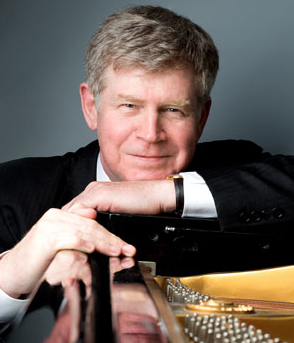Florida State University presents Ian Hobson in Review
Ian Hobson, piano
Judy and Arthur Zankel Hall at Carnegie Hall, New York, NY
March 11, 2019
Pianist Ian Hobson played a wide-ranging, difficult recital at Zankel Hall on March 11th, which made me answer the following questions in the affirmative: Can a pianist with immense bravura technique also, 1) be intellectually probing, 2) be poetically sensitive, and 3) create imaginative, thoughtful programs? It was in those areas where Mr. Hobson truly surrendered to his pensive, lyrical impulses that he created true magic, though I realize, even as I write those words, that such areas were set-off even more by what was around them. I reviewed Mr. Hobson’s heroic survey of the complete piano music of Debussy and Ravel elsewhere in these pages – Ian Hobson- Debussy/Ravel: April 18. 2018, Ian Hobson- Debussy/Ravel: February 28, 2018, Ian Hobson- Debussy/Ravel: February 7, 2018, Ian Hobson- Debussy/Ravel: November 29, 2017.
The evening began with Beethoven’s two-movement sonata in E minor, Op. 90. The first movement, in the minor, is a study in contrast and concision, with anger, melancholy, and even a nostalgic wistfulness, which Mr. Hobson brought out beautifully. Then the falling minor third is transformed into a rising major third for the second movement, a rondo that captures Beethoven in rare Schubertian expansion. Rather than a love-song for all humanity, I’ve always thought it quite personal, possibly even to the “immortal beloved,” whoever she might have been. Here, I wish Mr. Hobson had followed the nicht zu geschwind (not too fast) indication, giving a bit more gemütlichkeit, time spent allowing the music to unspool. Nevertheless, it was well-played.
He then followed with some Mendelssohn that had a Beethoven connection, the Variations sérieuses, Op. 54, which was part of the general fund-raising initiative for the Beethoven monument in Bonn (unveiled in 1845), to which Chopin, Liszt, and Schumann, among others, also contributed. The work is a set of evolving accelerations (primarily) on an original, chromatic, sober theme in D minor, called “serious” to differentiate it from the many sets of variations brillantes based on existing popular tunes or opera arias that composers were expected to churn out for the growing amateur market. The somber minor key is broken only once, about three-fourths of the way through with a D major, hymn-like moment of calm amid the storms. Mr. Hobson organized all the furor with his mighty skills, though I wished for more quiet at the outset, lower dynamics and more contrast in places, so the journey could “go farther.” It was an exciting rendition of a piece I wish was played more often.
The first half concluded with Schumann’s third sonata (the first to be started, however), in G minor, Op. 22. Here Mr. Hobson was truly magnificent. He was right in his element, handling all the manic rhythmic dislocation and busy-ness with complete command. He brought out the many polyphonic felicities in the first movement, but it was in the slow movement, based on an early song of Schumann, that he created spellbinding magic with his quiet playing. The rondo finale, marked Presto, was a wild ride that delighted the entire audience, justly so, yet he phrased the contrasting lyrical theme with greatest sensitivity, varying it through its many repetitions.
After intermission came an old chestnut that one rarely hears these days, Ernő Dohnányi’s Rhapsody in C major, Op. 11, No. 3. I have heard the legendaries (think Annie Fischer or Shura Cherkassky) sport with this four-and-a-half minute madcap, antic piece just as a kitten would play with a ball of string. Mr. Hobson added an element of substance to the piece without losing the humor entirely; that seemed to say he was making it a “more important” piece, and why not.
Then came a world premiere from American composer/conductor/pianist Robert Chumbley, titled Brahmsiana II (Brahmsiana I is an orchestral ballet score). As the composer states, this is no pastiche and no quoting of Brahms takes place; rather it was inspired by certain compositional techniques of Brhams. The three “new intermezzi” were in Chumbley’s characteristic lush neo-Romantic style, and they used the piano gratefully, even if I wasn’t really feeling much about Brahms per se. Chumbley doesn’t quite possess Brahms’ austerity or motivic unity. I sensed that in the first two pieces, the endings came too quickly, they didn’t feel organic and inevitable; but the third made a satisfying conclusion indeed. Mr. Hobson’s detailed and lavish colorations really added value to this group.
The recital concluded with Chopin’s masterful third piano sonata, Op. 58 in B minor. Here Mr. Hobson’s magic occurred in the elfin-light Scherzo and its heartbreaking contrasting middle section; his funereal song third movement was stately and gorgeous too. My only quibble was with the outer movements, which were played too fast—the first (Allegro) is qualified by maestoso (stately, dignified, majestic), it was pushed; the finale is marked (admittedly odd): Presto non tanto (not too presto). Here, for me, it was “too,” causing a lot of details to fall by the wayside, and reminding me of the early 20th century curmudgeon Henry Krehbiel, who I believe referred to this movement as “the parade ground of the virtuosi.” Still, it was an astonishing display of digital ability, fiery and completely involved emotionally, and it thrilled the audience to no end.
Mr. Hobson offered two (strongly earned!) encores: Tchaikovsky/Rachmaninoff’s Lullaby, Op. 16, limpid and full of elegant sorrow. The second was the Mendelssohn/Rachmaninoff Scherzo from the incidental music to A Midsummer Night’s Dream, more than enough for four, let alone two, hands. (Did I even hear some extra notes added, via Horowitz or perhaps Hobson?) Mr. Hobson’s presentation of the major-key lyrical theme that occurs twice was breathtakingly light, as was his “vanishing” conclusion.

